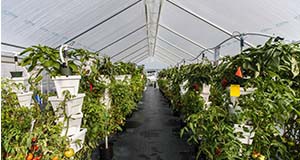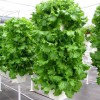
Many small farms are implementing greenhouse hydroponic systems. Perhaps the most challenging aspect of crop management for smaller growers is the control of water and nutrient delivery in a soilless media system. This six-page fact sheet focuses on relatively inexpensive strategies to help small growers know both when to start irrigation events and how long to run a single event when growing in soilless media. Written by Robert C. Hochmuth, Natalie B. Parkell, Wanda L. Laughlin, and Sean C. Rider, and published by the Horticultural Sciences Department.
http://edis.ifas.ufl.edu/hs1274
Tag: Hydroponic Production
Selecting Cultivars of Lettuce For Production Using Hydroponics and Protected Culture in Florida
 With correct variety selection and protected culture strategies, lettuce is a crop that can present even the novice grower with a fast-growing commodity for market sale. Includes brief descriptions of hydroponic lettuce production systems, cultivars, and a table summarizing the lettuce types successfully grown in Florida using protected agriculture and hydroponic techniques. This 6-page fact sheet was written by Natalie B. Parkell, Robert C. Hochmuth, and Wanda L. Laughlin, and published by the UF Department of Horticultural Sciences, March 2015. (Photo: UF/IFAS)
With correct variety selection and protected culture strategies, lettuce is a crop that can present even the novice grower with a fast-growing commodity for market sale. Includes brief descriptions of hydroponic lettuce production systems, cultivars, and a table summarizing the lettuce types successfully grown in Florida using protected agriculture and hydroponic techniques. This 6-page fact sheet was written by Natalie B. Parkell, Robert C. Hochmuth, and Wanda L. Laughlin, and published by the UF Department of Horticultural Sciences, March 2015. (Photo: UF/IFAS)
http://edis.ifas.ufl.edu/hs1258
Characterization of the Florida Fresh Fruit and Vegetable Industry Using Hydroponic Systems or Protected Agriculture Structures
 UF/IFAS Extension faculty, allied industry representatives, and growers determined the need to assess the size and scope of the protected agriculture industry in 2013 by surveying growers in Florida. The primary focus was to document the types of protected agriculture structures, crops, and growing systems being used. In addition, secondary information on location of operations, pest concerns, expected expansion, etc. was collected on many operations. The results documented a significant expansion of the industry in terms of both size and scope. This 8-page fact sheet was written by Robert C. Hochmuth and Dilcia E. Toro, and published by the UF Department of Horticultural Sciences, August 2014.
UF/IFAS Extension faculty, allied industry representatives, and growers determined the need to assess the size and scope of the protected agriculture industry in 2013 by surveying growers in Florida. The primary focus was to document the types of protected agriculture structures, crops, and growing systems being used. In addition, secondary information on location of operations, pest concerns, expected expansion, etc. was collected on many operations. The results documented a significant expansion of the industry in terms of both size and scope. This 8-page fact sheet was written by Robert C. Hochmuth and Dilcia E. Toro, and published by the UF Department of Horticultural Sciences, August 2014.
http://edis.ifas.ufl.edu/hs1240
HS1186 Solutions for Small Farmers and Home Gardens: Building a Low-Cost Vertical Soilless System for Production of Small Vegetable and Fruit Crops
HS1186, a 5-page illustrated fact sheet by Bielinski M. Santos, Teresa P. Salame-Donoso, and Shawn C. Arango, provides written and graphic instructions on how to build a homemade vertical soilless (hydroponic) growing system (also known as “bottle grow”) to produce vegetables and small fruit crops at a fraction of the cost of commercially available systems, without occupying premium agricultural land and by utilizing materials available in the home and local hardware store. Published by the UF Department of Horticultural Sciences, November 2010.
http://edis.ifas.ufl.edu/hs1186
HS1164 Microgreens: A New Specialty Crop
HS1164, a 3-page illustrated fact sheet by Danielle D. Treadwell, Robert Hochmuth, Linda Landrum, and Wanda Laughlin, provides an overview of this new type of market crop and its production. Includes references. Published by the UF Department of Horticultural Sciences, May 2010.
http://edis.ifas.ufl.edu/hs1164
HS405 Hydroponic Vegetable Production in Florida
HS405, an 8-page illustrated fact sheet by Richard Tyson, Robert Hochmuth and Daniel J. Cantliffe, provides an overview of hydroponic vegetable production in Florida — history, marketing considerations, growing systems, seasonal limitations, and economic considerations. Includes references. Published by the UF Department of Horticultural Sciences, November 2009.
http://edis.ifas.ufl.edu/HS405